IX Key Figures and Organizations Related to the Qiansicang Story Painting Paper Money Plate
1. Huang Jun (黃濬)
2. Huang Jun's Tsun Ku Chai Antique Shop (尊古齋)
3. Tanaka Keibun (田中啟文)
4. Tanaka Keibun's Sempeikan Museum (田中清岳堂)
5. Currency Museum Bank of Japan
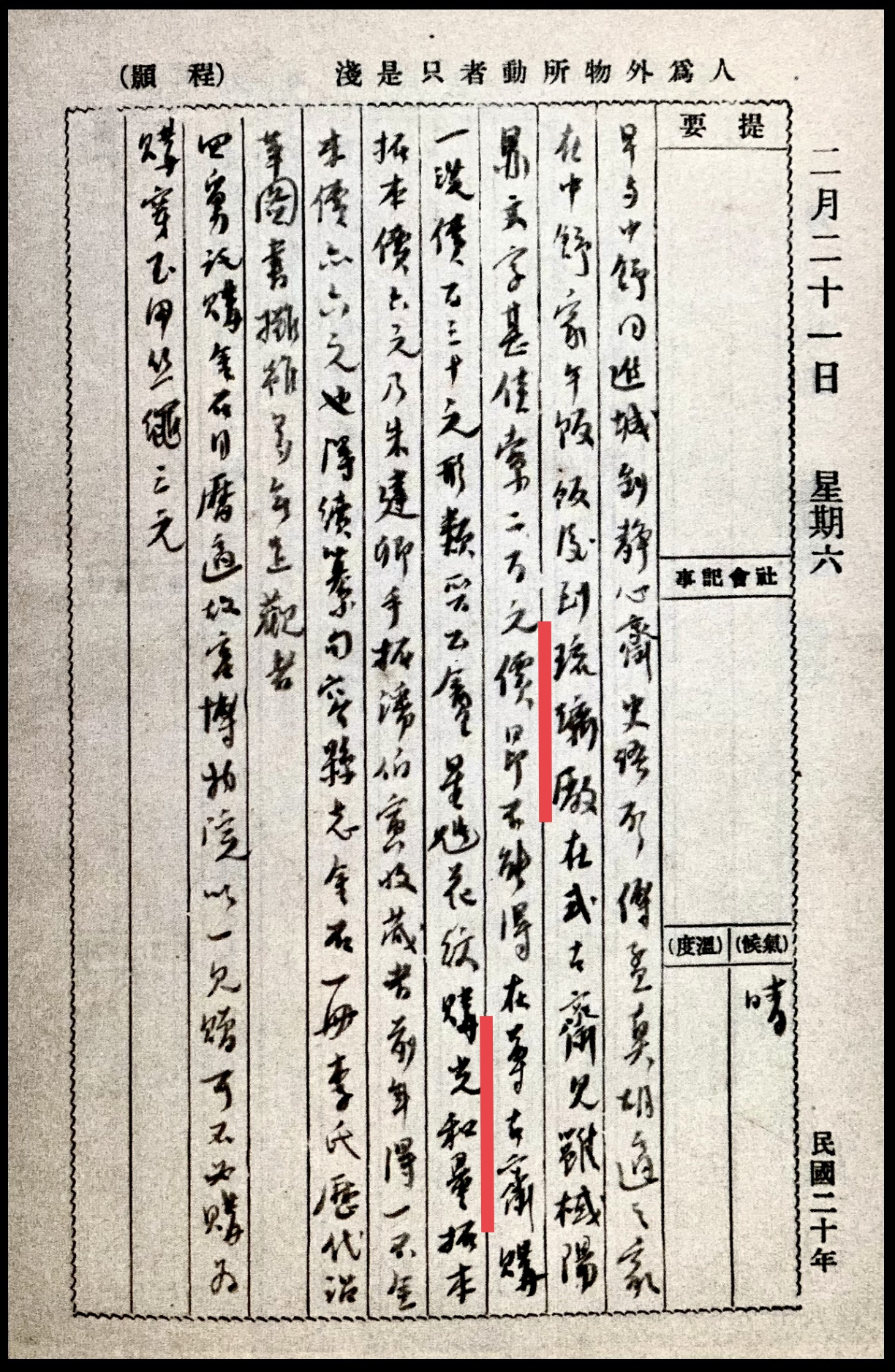 |
| An Account of Tsun Ku Chai at the Glass Factory in Rong Geng's Dairy in Peking (《容庚北平日記》) on February 21, 19314949 |
1. Huang Jun
Huang Jun (1880-1952), also known as Huang Baichuan ( 黃百川 ), was a native of Yunmeng, Hupeh. He was the owner of Tsun Ku Chai Antique Shop at the Glass Factory in Beijing. He was also a cultural relics connoisseur, known as "Millionaire Huang".48 He set up the Tsun Ku Chai Antique Shop at the Glass Factory in Beijing, excelled in identifying antiques, and had many collectibles. He wrote 'The Collection of Tsun Ku Chai' (《尊古齋古鉥集林》) and 'The Collection of Pottery Buddha in Tsun Ku Chai' (《 尊古齋陶佛留真 》).
2. Huang Jun's Tsun Ku Chai Antique Shop
The owner of Tsun Ku Chai Antique Shop in the Glass Factory was Huang Jun. Other antique stores at the Glass Factory, Beijing in business during the same period included Shi Ku Chai, Po Ku Chai, Te Ku Chai, Chian Ku Chai, Te Pao Chai, Ta Kuan Chai, Yan Ku Chai, Ku Kuang Ke, and Lai Tsun Ke.50 The period from 1920 to 1940 was a golden time for the bronzeware, painting, and calligraphy business at the Glass Factory51. Many antique collectors and researchers visited there frequently. Rong Geng,52 then a professor at Yenching University in Beijing, was one of these frequent visitors. His diary records:
Saturday, February 21, 1931, sunny. I went into the town with Chung Shu (中舒) in the morning. We visited Fu Meng-chen (傅孟真) and Hu Shih (胡適) first. Then, we had lunch at Chung Shu's house. After lunch, we went to the Glass Factory. We saw a ding [鼎, an ancient cooking vessel with two loop handles and three or four legs] of Yuyang (棫陽, a place name) made by Yong (雝, the name of a noble) at the Shi Ku Chai with nice inscriptions. The shop owner offered 200 silver dollars, but I could not afford it. I purchased a xi [洗, a Chinese brush washer] for 30 dollars. It is similar to the an【an】of Jin Gong [晉公, the Duke of Jin] with star and snake patterns in the Tsun Ku Chai Antique Shop. I also bought a book of rubbings made by Chu Chian Tsing (朱建卿) and collected by Pan Po Yin (潘伯寅) for 6 silver dollars. I bought an incomplete rubbing book at the same price one year ago. In addition, I purchased a 'Renewed Compilation of Jurong County – Bronzewares' (《續纂句容縣誌·金石》) and Lee's 'History Map' (《歷代沿革圖》). Although there were many book stalls, there were not so many visitors. My fourth uncle asked me to purchase a bronze calendar. I happened to received one as a present from the Palace Museum, so there was no need to purchase it. I just bought silk rope for threading for 3 dollars. 53
'Rong Geng's Dairy in Peking records' once said "Rong Geng's Dairy in Peking".54 It was the first time for Rong Geng to visit an antique store on April 28, 1928. He began with Tsun Ku Chai at the Glass Factory.55 The diary has several references to the transaction and communication with Huang Jun in the Tsun Ku Chai. The last related record mentions that "on Tuesday, September 19, 1939, I inscribed six rubbings of swords for Huang Jun."56 This shows that Huang Jun was still active in Beijing and the Glass Factory in 1939. (According to Masahiro Okudaira's (奧平昌洪) 'Toa Senshi' (《東亞錢志》) in 1938, the plate had already been housed in Tanaka Keibun's Sempeikan Museum.)
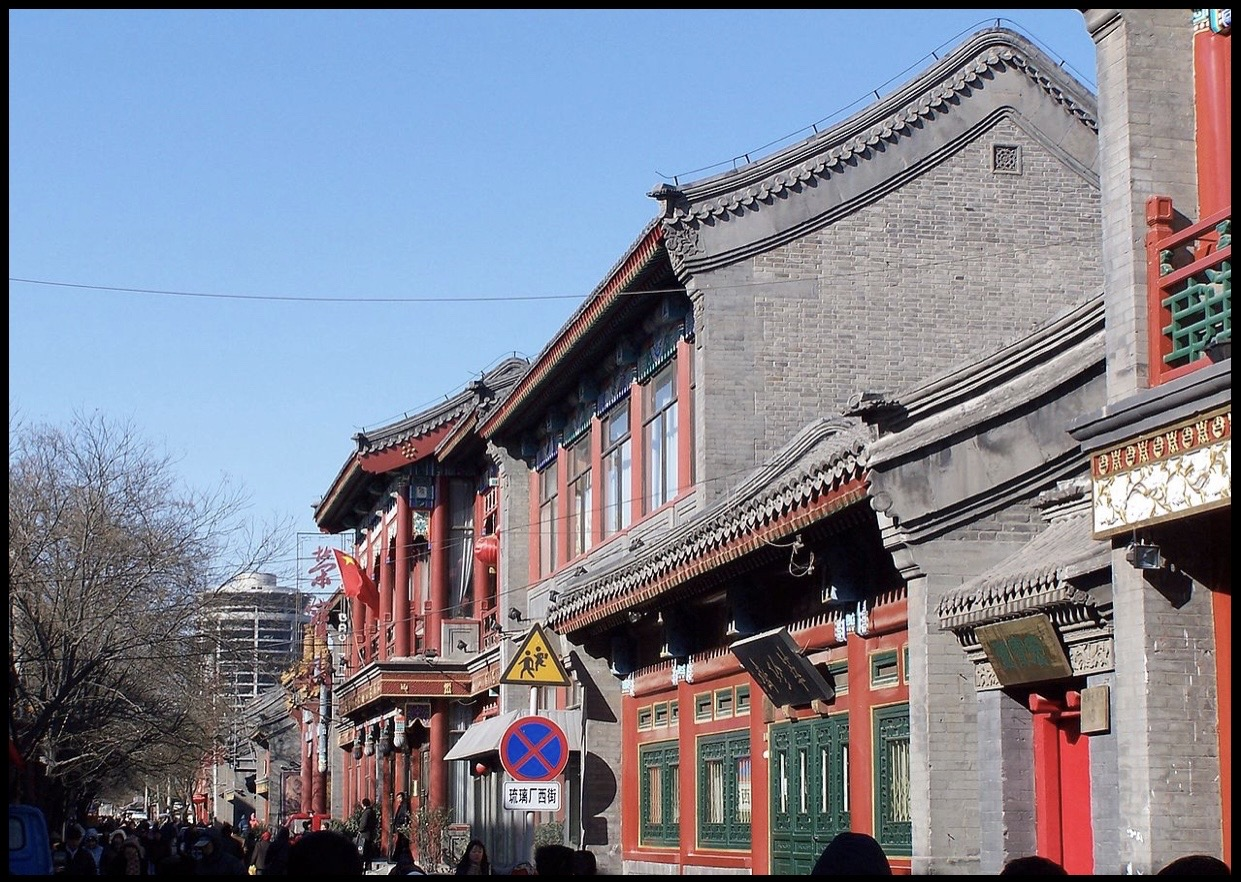 |
| Huang Jun's Tsun Ku Chai Antique Shop was located at the Glass Factory, Beijing |
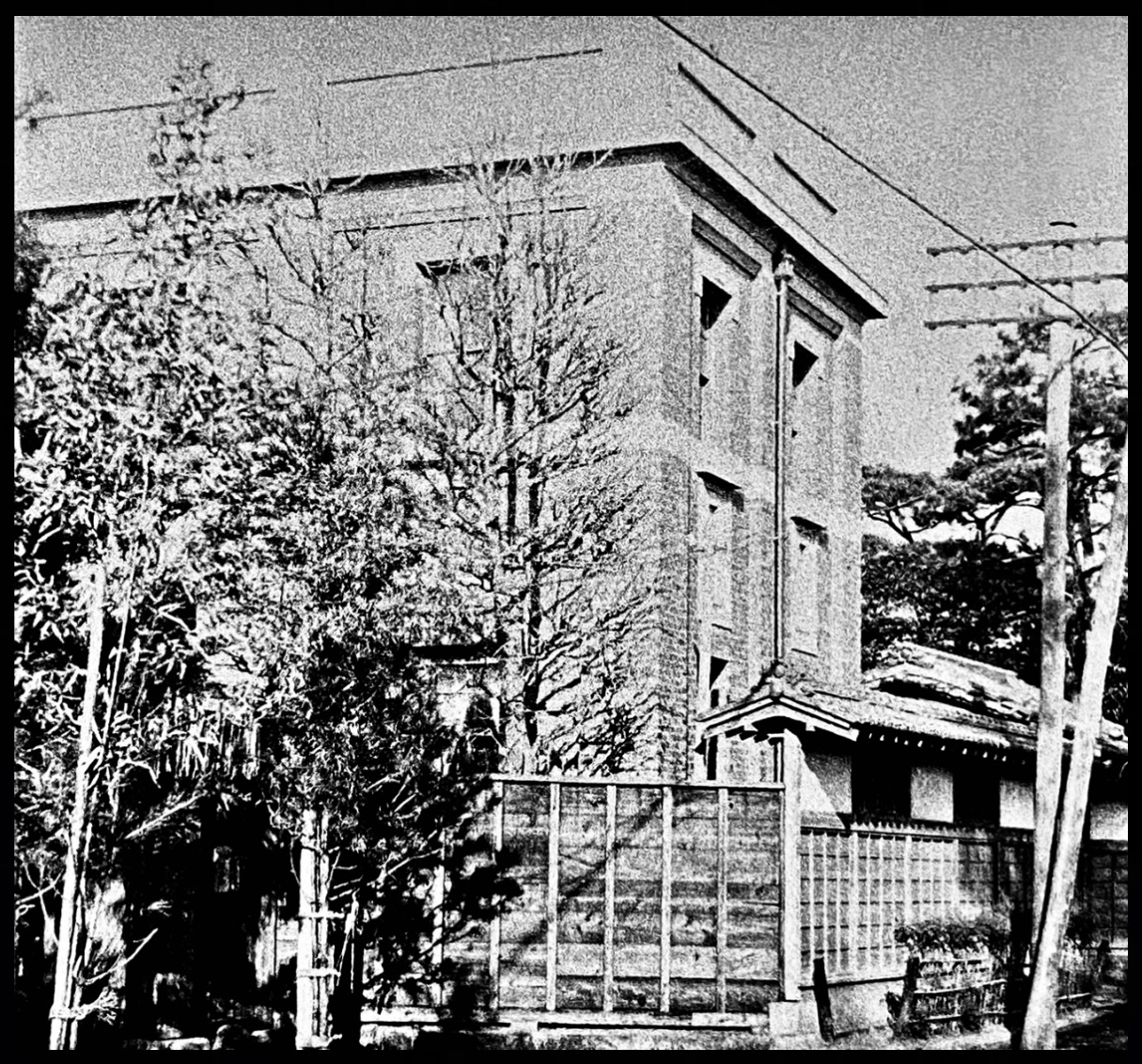 |
|
| The Western-style Sempeikan Museum owned by Tanaka Keibun located at Shirokane, Tokyo557 |
3. Tanaka Keibun
Tanaka Keibun (1884 – Dec. 1, 1954), born in Shirokane, Tokyo, originally named Tanaka Ken (田中謙), and his house is known as Sempeikan.
In 1902, he joined the Japan Currency Research Society. In 1906, he joined the Koizumi Association in Tokyo and began collecting and studying coins. In 1918, the Tokyo Coin Association was renamed the Tokyo Numismatic Association. In 1920, he became the president of the Tokyo Numismatic Association, and in 1923, he set up the Western-style Sempeikan Museum at Shirokane, Tokyo.58
From December 1944 to January 1945, he donated more than 100,000 items from his collection to the Bank of Japan.59 In July 1950, he founded the monthly numismatic journal 'Sempeikan', which ran for 44 issues (after the death of Tanaka Keibun, his descendants took over until the 56th issue when the journal was discontinued). He passed away on December 1, 1954, at the age of seventy.60
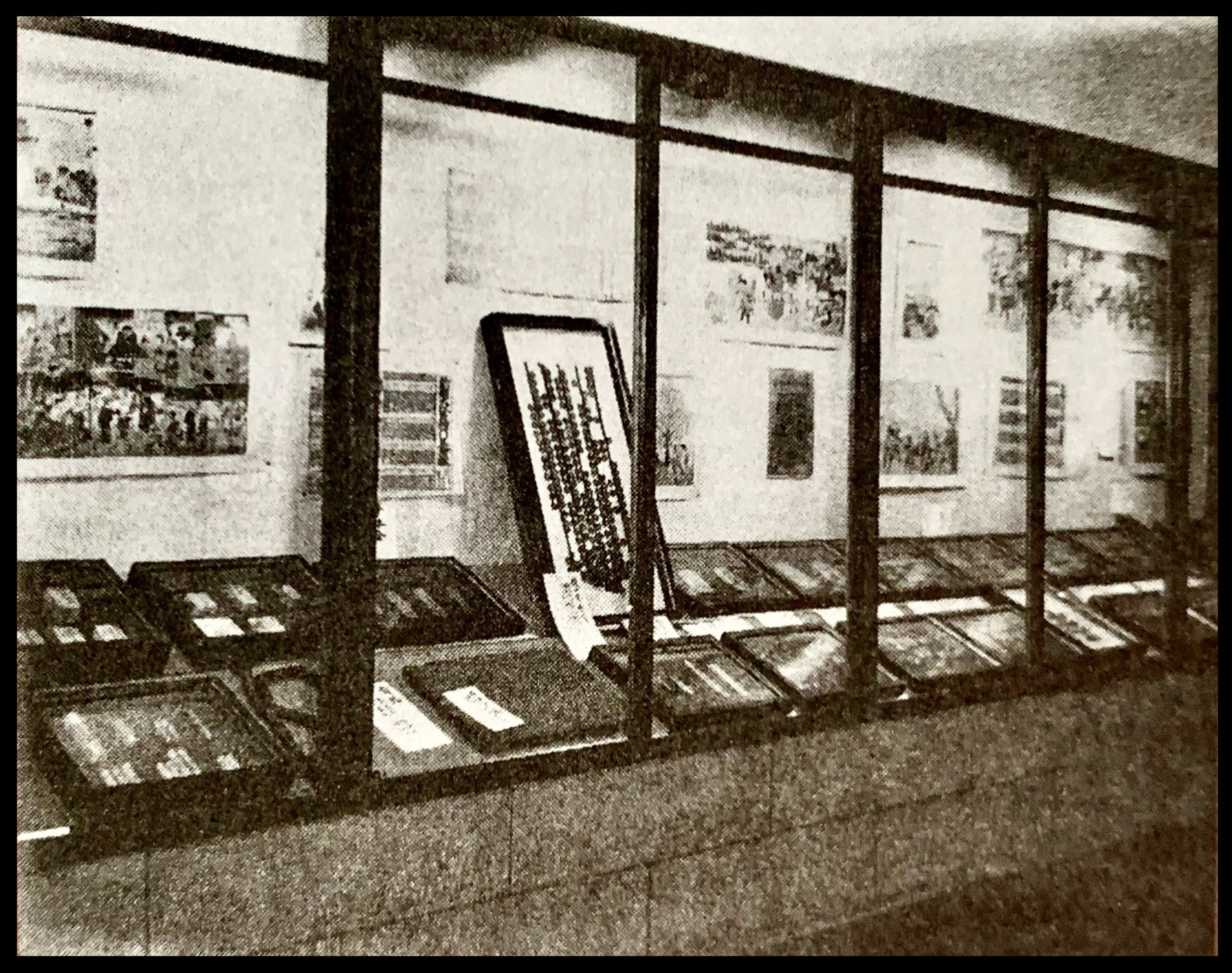 |
| The interior of the Sempeikan, which used to house the plate 61 |
4. Sempeikan Museum
a. Establishment
In 1923, Tanaka Keibun established the Sempeikan Museum at his Western-style residence in Shirokane, Tokyo, to display his collection of coins and related items. He had good relations with Toyotaro Yuki (結城豐太郎, 1877-1951) and Shibusawa Keizo (澀澤敬三, 1896-1963). Tanaka Keibun chose the Bank of Japan to donate because of his good relationship with Toyotaro Yuki, the fifteenth president of the Bank of Japan (July 1937-March 1944), who had discussed the future of the Numismatic Museum's collection with him. In 1942, Shibusawa Keizo, who emphasized and loved culture and history, visited the Sempeikan Museum.62 Tanaka Keibun donated the Sempeikan Museum to the Bank of Japan when Shibusawa Keizo assumed the sixteenth president of the Bank of Japan (Mar. 18, 1944-Oct. 9, 1945).63
b. Donation to the Bank of Japan
From December 1944 to January 1945, Tanaka Keibun donated more than 100,000 coins and related items from the Sempeikan Museum to the Bank of Japan through Shibusawa Keizo to prevent the collection from being affected by the war.64 This donated collection became the centerpiece of the collection of the Currency Museum Bank of Japan.65 Tanaka Keibun's "Catalog of Sempeikan Museum Collection" was published in September 1944.66 This is the fate and origin of the collection of the Sempeikan Museum and the Bank of Japan.
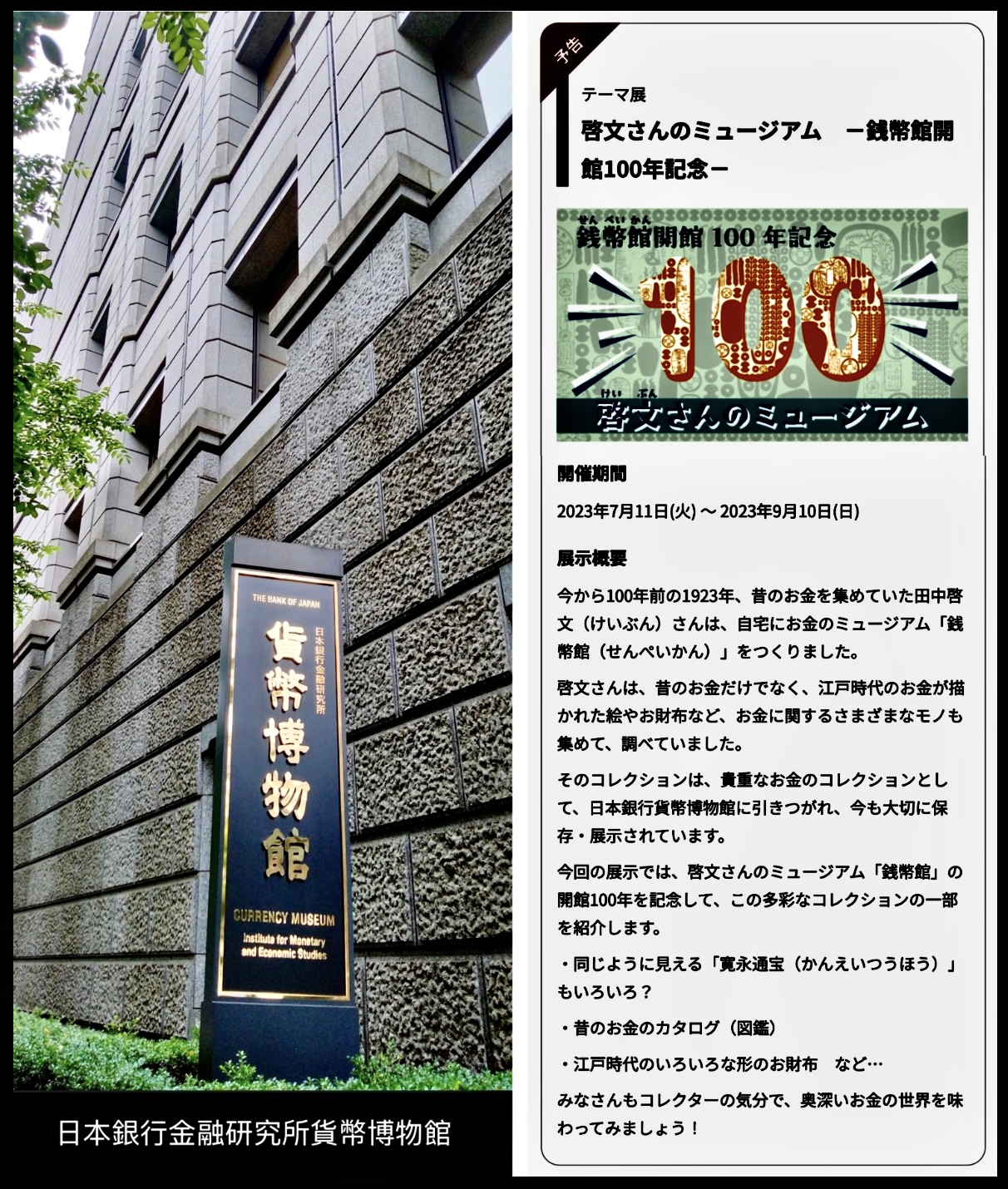 |
| The special and permanent exhibitions commemorating the 100th anniversary of the founding of the Sempeikan Museum |
5. Special and Permanent Exhibitions at the Currency Museum Bank of Japan
a. The Special Exhibition commemorating the 100th Anniversary of the Founding of the Sempeikan Museum Set up by the Bank of Japan
To commemorate the 100th anniversary of the establishment of the Sempeikan Museum by Tanaka Keibun in 1923, the Currency Museum Bank of Japan, organized a special exhibition from July 11, 2023 to September 10, 2023, in memory of Tanaka Keibun, who was a pioneering collector of coins and an important donator to the museum.67
The location of the Museum is Nihonbashi Honzoku-cho, Chuo-ku, Tokyo. This is a special exhibition to commemorate the 100th anniversary of the establishment of the Sempeikan Museum by Tanaka Keibun. The exhibition space is not very large, with only a small portion of the old collection of the Sempeikan Museum donated by Mr. Tanaka Keibun, all of which were Japanese coins, with no paper money. The exhibit included items such as ancient Japanese coins and old wallets that were used in Japan.68
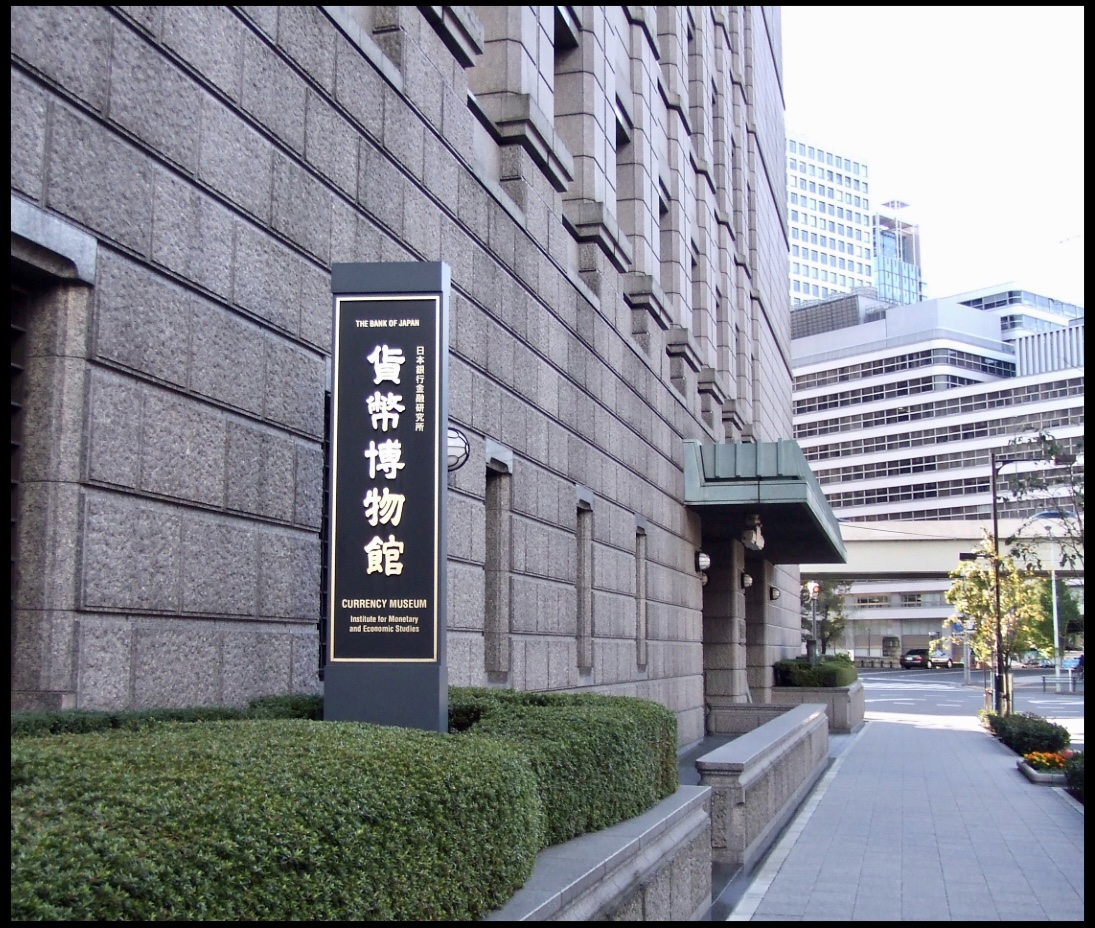 |
| The Currency Museum Bank of Japan |
X The Destination and Collection of the Qiansicang Story Painting Paper Money Plate
The Destination and Collection of the Qiansicang Story Picture Paper Money Back Plate
1. Before 1924, the plate was in the collection of Huang Jun, the owner of the Tsun Ku Chai Antique Shop at the Glass Factory, Beijing.70
3. From December 1944 to January 1945, the plate went to the Currency Museum Bank of Japan's collection. (From December 1944 to January 1945, Tanaka Keibun donated to the Bank of Japan more than 100,000 items from the Sempeikan Museum, including ancient currencies as well as important documents, paintings, and folklore materials for the study of Japan's monetary and economic history.)72
On August 22, 2023, I received an official reply from the Currency Museum Bank of Japan, confirming that the original banknote plate is one of the items in its collection."73
A special thanks to the Currency Museum Bank of Japan for its response!
On the occasion of the 1,000th anniversary of the issuance of banknotes, it is undoubtedly an exciting piece of good news that the plate is still kept well.
XI Figures and Writings
1. Tanaka Keibun (1884 - December 1, 1954)
Tanaka Keibun founded the monthly numismatic journal 'Sempeikan' (July 1950-January 1956, Issue 1 to Issue 56).
2. Masahiro Okudaira (1865 - deceased unknown)
'Toa Senshi', in eighteen volumes, by Masahiro Okudaira, was issued on June 20, 1938, by Iwanami Shoten, Tokyo.
 |
 |
 |
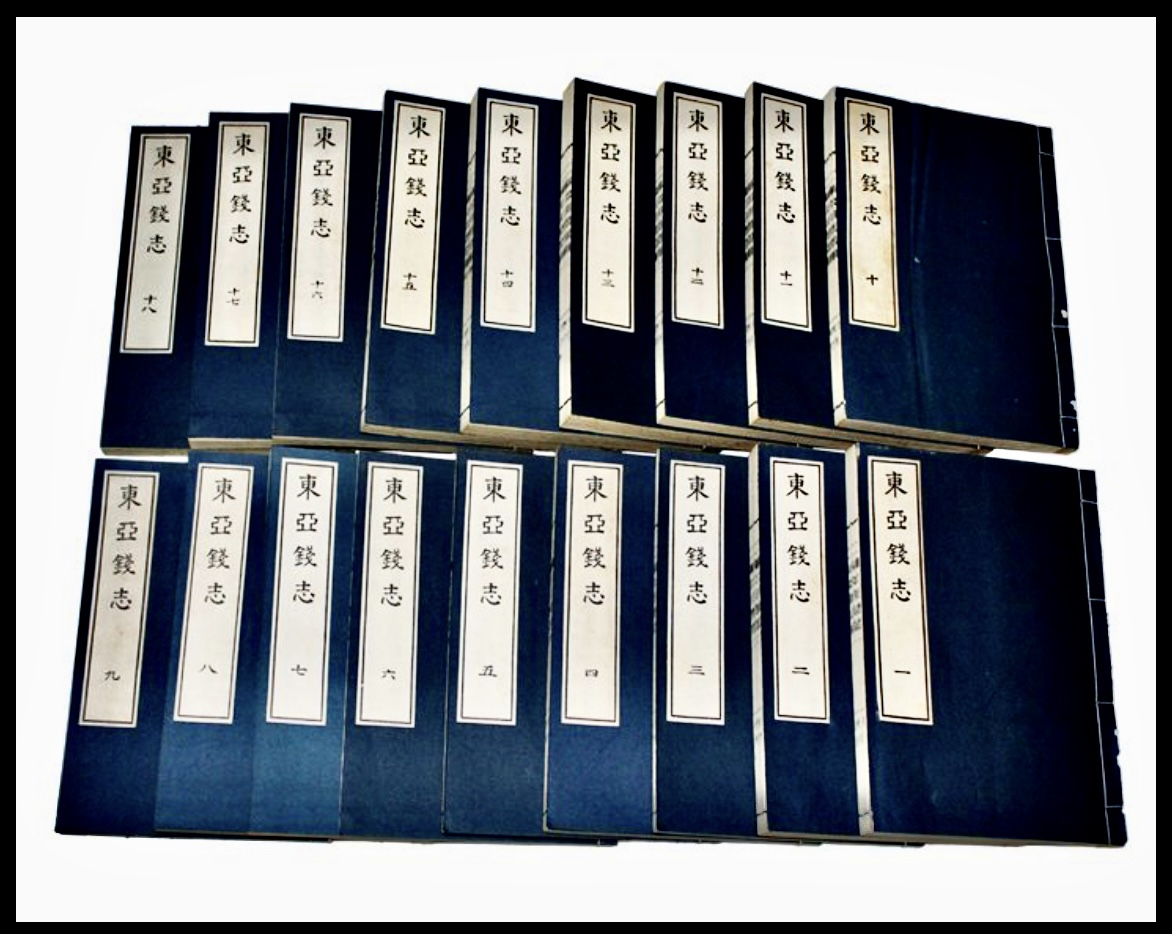 |
| Tanaka Keibun74 | 'Sempeikan' monthly journal | Masahiro Okudaira75 | 'Toa Senshi' |
Chapter IV Postscript and Conclusion
XII Postscript
It has been my goal for many years to explore the flow and characteristics of the qiansicang paper money plate. In 2004, I founded the Chinese Ancient Banknote Society76 in Hong Kong together with fellow ancient banknote enthusiasts, to study ancient banknotes. In order to see the complete description and original design of the plate in Masahiro Okudaira's 'Toa Senshi', I commissioned Mr. Isamu Morimoto77, a Japanese collector of Chinese banknotes, to purchase the entire set of 'Toa Senshi' from Japan in 2003. At that time, I saw for the first time the obverse and reverse of the plate and its dimensions.78 Mr. Otoku Wado assisted me in translating the Japanese description of the plate in the book to Chinese.
Fortunately, I found an important clue that the owner of the Sempeikan Museum is Tanaka Keibun on a Japanese website. Following the clue, I found the Currency Museum Bank of Japan. Finally, by contacting the Museum,79 I received a reply, confirming that the plate was in its collection. The Museum also provided an image of a printed copy of the plate for me80, and thus my writing was completed.
A few years ago, I gained a volume of Yi Lin Ten-Day Journal (《藝林旬刊》) published in 1928,81 which is the first time the image of the plate was published anywhere. At the end of November 2021, a rubbing of the plate with the annotation and the information about the origin of the collection dated 1928 appeared in the 2021 Jiashutang Rubbing Collection Auction in Beijing, which gave me extremely important information that the plate was collected by Huang Jun of the Tsun Ku Chai Antique Shop at the Glass Factory, Beijing.
XIII Conclusion
The year 2024 is an important year for the establishment of the Jiao Zi Bureau (交子務) and the 1000th anniversary82 of the official release of jiao zi [交子]. One thousand years ago, the Song government made an epoch-making and important decision in Yizhou, Sichuan Province (present-day Chengdu, Sichuan Province) to establish the Jiao Zi Bureau and issue the jiao zi.83 We would like to commemorate this event of far-reaching significance.
The qiansicang story painting paper money plate is the earliest paper money plate ever seen in existence, which is of great significance. I look forward to discovering other plates in the future to corroborate the history of paper money issuance. This paper takes this opportunity to report on and examine84 to commemorate and appreciate the contributions made by the sages in the invention and utilization of paper money as well as the far-reaching impact of banknotes on the convenience of the people and the socio-economic development.
XIV Appreciation
[1] Currency Museum Bank of Japan
[2] Mr. Zhou Weirong (周衛榮), Director of the China Numismatic Museum and Secretary General of the China Numismatic Society
[3] Mr. Gao Congming (高聰明), Deputy Director of China Numismatics Museum, Chief Editor of "China Numismatics" magazine
[4] Mr. Chen Qi (陳祺) from the editorial department of China Numismatics magazine
[5] Mr. Isamu Morimoto (森本勇)
[6] Mr. Otoku Wado
Note:
48 Rong Geng, Rong Geng's Dairy in Peking, Chung Hwa Book Co., 2019, p. 300.
49 59 Rong Geng, Rong Geng's Dairy in Peking from January 1921 to February 1946.
51 Ma Heng (馬衡), Fu Ssu-nien (傅斯年), Shang Chengzuo (商承祚), Yu Xingwu (于思泊), Gu Jiegang (顧頡剛), Yang Zhensheng (楊振聲). Rong Geng recorded in his diary that he often visited the antique shops at the Glass Factory with Yu Xingwu and Shang Chengzuo.
52 Rong Geng (September 5, 1894 - March 6, 1983), original name Zhao Geng, also named Xi Bai, Song Zhai, native of Dongguan, Guangdong Province, was a Chinese paleographer who studied ancient writings under Luo Chen-yu (羅振玉). His works include 'A Compilation of Inscriptions on Bronze' (《金文編》) (edited in 1925), 'Continuation of A Compilation of Inscriptions on Bronze' (《金文續編》), 'Research on Sacrificial Vessels in the Shang and Zhou Dynasties' (《商周彝器通考》, published in 1941).
53 Rong Geng, Rong Geng's Dairy in Peking, Chung Hwa Book Co., 2019, p. 228.
54 Rong Geng, Rong Geng's Dairy in Peking, Chung Hwa Book Co., 2019, p. 151-152. the time Ronggeng first went into store was Saturday, April 28, 1928, The record about Rong Geng's first visit to antique shops. "I had never visited antique shops. Short of money, I could not afford these antiques though I am keen on them. Visiting antique shops could only make me think of them in vain. Today the accounting director Bliss M. Wiant and I went to the antique store to buy ancient coins. We went to the Fang Ku Chai at the Glass Factory first. to visit the Ku Chai. I purchased 2 mirrors of the Han dynasty and more than 10 ancient knife coins for 20 dollars. Wiant left for something else. Then, I went to Tsun Ku Chai with James Mellon Menzies. I purchased a yang er ding [a ding of the State of Yang] at 50 dollars, and a mirror with three goat patterns and a small seal for 8 dollars. I also bought a calligraphy from the Wu Dacheng (吳大澂) collection. Since it was damaged in the middle, so I would have purchased it for a discounted price of 280 dollars. However, the price was a mistake, as the shop purchased it for over 300 dollars. I would not like to ask the store to sell reluctantly. The ding recorded in the 'List of Bronzewares Collected in the Empire Palace of the Qing Dynasty' (《西清古鑒》) is the first antique I purchased, and it was luck for me to gain it at a bargain. I found a suitable lid for the ding later (the lid was not recorded in the List). The mirror I purchased is fine in inscription, pattern, and color."
56 Rong Geng, Rong Geng's Dairy in Peking, Chung Hwa Book Co., 2019, p. 588.
57 Image in Permanent Exhibition Display Catalogue 2022 published by the Currency Museum Bank of Japan.
58 Website of Japan Tokyo Numismatic Association.
59 60 Tanaka Keibun, Sempeikan, October 1950, No. 4, pp. 138-150 (Tanaka Keibun has a small portrait in the journal.)
61 Image in Permanent Exhibition Display Catalogue 2022 published by the Currency Museum Bank of Japan.
62 63 Image in Permanent Exhibition Display Catalogue 2022 published by the Currency Museum Bank of Japan.
64 Tanaka Keibun, Sempeikan, October 1950, No. 4, 138-150.
65 66 Image in Permanent Exhibition Display Catalogue 2022 published by the Currency Museum Bank of Japan.
67 Official information published by the Currency Museum Bank of Japan.
68 69 Site of the exhibition hall of the Currency Museum Bank of Japan.
70 2021 Guardian Beijing Autumn Auction, Catalogue of the Jiashutang Rubbing Collection.
71 Masahiro Okudaira, Toa Senshi 1938.
72 Permanent Exhibition Display Catalogue 2022 published by the Currency Museum Bank of Japan.
